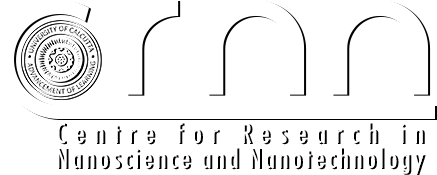CRNN SCOPE
CRNN provides an interdisciplinary research platform covering the fields of Physical, Chemical, Biological Sciences and Engineering aspects. This provides a unique opportunity to avail instruments under one umbrella those are otherwise commonly related to various individual subject domains. Faculty members from various departments of University of Calcutta are actively involved with the operation and maintenance of the facilities at the center. Broad research areas at CRNN include nanosynthesis, nanomaterials and devices, nanoscale phenomenon, and biomaterials and health applications. Research activities focus on nanofabrication, polymer nanoparticles, semiconductor nanoparticles, photophysics, magnetic materials, photocatalysis, nanoemulsion, nanotoxicology, theranostics, nanophytobiology; among others. PhD program at CRNN is ongoing, and the center is actively involved in organizing academic programs in the form of conference, workshop, seminar, winter/summer school.
Vision :
Creation of a Center of Excellence for interdisciplinary research in Nanoscience and Nanotechnology, including Physical, Chemical and Biological Sciences.
Rationale :
In recognition of its glorious contribution for the last 150 years, The Honorable Finance Minster, Govt. of India, allocated to the University of Calcutta Rs 100 Crores for pursuing research in emerging sciences and technologies of national importance. The University decided to utilize this fund for the creation of a Center for Research in Nanoscience and Nanotechnology, to meet global challenges in this area.
Thrust Areas :
The University has decided to utilize its vast and divergent expertise in Physical, Chemical, Biological Sciences and Technology, and pursue a truly synergetic approach towards meeting the goals of the CRNN. The major thrust will be in the area of nanofabrication guided by requirements of high degree of control at the nanometer scale. In addition, characterization of nanoscale materials in order to fully understand their novel properties is essential. Such structures will be integrated into macro-scale products through hierarchical integration processes. Side by side, powerful and versatile computational facilities are also essential for the proper understanding of the various physical phenomena. Highly efficient manufacturing processes are also envisaged, reducing material consumption and minimizing environment cost for new energy efficient products. Thus establishment of a viable technology transfer mechanism is therefore also a prime concern.
More than 50 faculty members from all science and technology branches are associated with CRNN. Topics include:
- Functional nanomaterials synthesis / Growth
- Nanostructure based electronic devices
- III-Nitride based optoelectronic devices
- Nanotechnology for pollution control
- Nanoencapsulation of bioactive lipids
- Food-grade, stable, non-toxic, biocompatible nanoemulsion
- Dilute magnetic semiconductors
- Transport property of nanostructures
- Photophysics on semiconductor nanoparticles
- Nanocomposites for protective coating
- Graphene based multifunctional composites
- Biobased composite.
- Nano-bio sensor design and development
- Nanotechnology inspired theranostics (cancer, skin disease, and different infectious diseases)
- Targeted drug delivery


